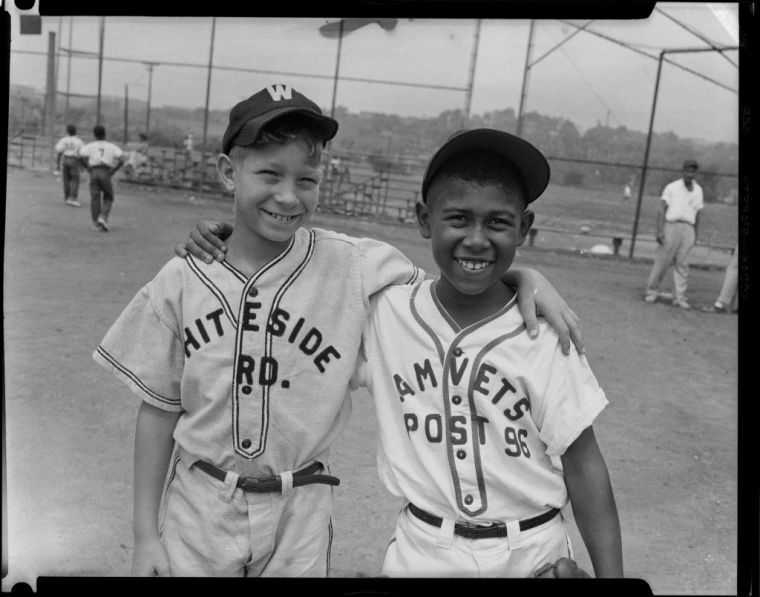Teenie Harris’s Love of Baseball, on Film
April 2, 2014
Now on display at the Carnegie Museum of Art is an exhibit showcasing Charles “Teenie” Harris’ love for the game of baseball — and it comes just in time for the start of the Major League season.
Harris, the historic photographer who worked for years with the Pittsburgh Courier, an African-American newspaper, amassed one of the most complete records of a community before his death in 1998. In honor of the opening of baseball season, the Carnegie Museum of Art is putting a special focus on the way that Harris — and the community — celebrated the sport of baseball.
Through photography, Harris captured the growth of Pittsburgh’s Hill District over the span of several decades, and according to Jonathan Gaugler, Media Relations Manager at the Carnegie Museum of Art, one of his favorite subjects was baseball.
“Baseball was such an integral part of the community that Teenie took over 700 photographs involving baseball,” Gaugler said.
Harris wasn’t just a casual fan — he had a personal connection to the game. He was one of the original founders of the Pittsburgh Crawfords sandlot team, an all-African-American baseball team based in the Hill District from 1931 through 1938 that was eventually absorbed into the Negro Leagues. It was there that the team became a perennial powerhouse alongside the other Pittsburgh Negro League team, the Homestead Grays.
Like all of Harris’s work, the photographs on display have a distinct connection to his community.
“That is very quintessentially Teenie: a focus on the game as a community event and not just the stars of the day,” Gaugler said.
That community element shows in the Carnegie Museum of Art’s newest exhibit. Though prints include pictures of Jackie Robinson, the first African-American to break the color barrier in Major League Baseball, that stands as the exception, not the rule.
The exhibit’s prints revolve around local female softball teams, photos of the well-dressed spectators that came to watch the Negro League games, and an intimate shot of Harris’s own grandson wielding a wooden baseball bat that is almost as large as he is.
Throughout all the pictures, there are picket fences, stacked apartment buildings and steel mill structures — reminding viewers of the intimacy of the game to the community and its distinctive Pittsburgh roots.
“There is real warmth to what Teenie does,” Gaugler explained.
According to Louise Lippincott, curator of fine arts at the Carnegie Museum and manager of the Teenie Harris Archive, Harris’s work exhibits the roles that these players had in the city.
“We have portraits of some of these baseball players behind the scenes — in their daily lives, in the Pittsburgh community — and you get a sense of not only the symbolic associations of having a great team, but also that these players played important roles for life in Pittsburgh,” Lippincott said.
Both Lippincott and Gaugler discussed one print in particular: a photograph of a parade that marked the integration of an Uptown Little League team in 1953 — a year before the Pittsburgh Pirates would do the same. Jackie Robinson, who was playing in Pittsburgh as a member of the Brooklyn Dodgers at the time, came out for the celebration.
Another exhibit standout is a photograph of two young players — one black, one white — arm-in-arm in baseball uniforms, smiling for the camera.
Sean Gibson, the great-grandson of Negro League star Josh Gibson and guest curator for the exhibit, isn’t surprised at the poignance of Harris’ work on baseball.
“I think he did a great job capturing not only the Negro Leagues, but people in general,” Gibson said. “He did a great job of capturing everything.”
For Lippincott, Gibson’s work on the exhibit was an added bonus.
“He has these very deep connections with Negro League history, but he is also very involved with sports for youth today, so we thought he was a great choice to connect the history with the present,” Lippincott said.
Gibson narrates rare video footage that Harris captured of Negro League baseball. Black and white shots of slick defensive plays greet guests as they enter the long hallway that houses the exhibit.
Lippincott said that when the group started to restore Teenie’s 16mm film, they discovered that he had shot and captured live-action footage from Negro League baseball games.
“And at that point we said, ‘We have to do this,’” she said.



